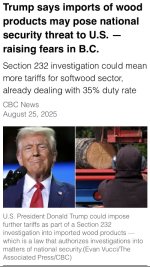The Tarriff Hype.
- Thread starter petros
- Start date
You are using an out of date browser. It may not display this or other websites correctly.
You should upgrade or use an alternative browser.
You should upgrade or use an alternative browser.
It had to be something out of Western Canada, or it wouldn’t be anything at all.The response to canola tariffs is fertilizer export taxes.
i was hoping that home electronics and computer electronics were not going to be terroriffed due to the aforementioned windows 10 coming to an end.So, in Canada’s latest Tariff manoeuvres, or counter-tariffs, etc…here’s a short list of items that Canadians have been paying tariffs on from America, that wholesalers & retailers would’ve already purchased, that will no longer be tariff’d as of the beginning of September.
A swath of poultry products, including turkey, chicken and eggs.
Dairy products, including milk, cream, butter, yogurt, cheeses, ice cream and margarine.
Various spices and seasonings, including: vanilla, pepper, cinnamon, nutmeg, thyme, ginger, cumin and others.
Fruits and vegetables, including tomatoes, cucumbers, citrus fruits, melons, berries and stone fruits.
Coffee and tea.
Grain products, including wheat, rye, barley, oats and rice.
Cooking oil products, including canola, palm oils, and sunflower oils.
Shrimp and prawns.
Confectionery products, including flours, sugars, honey, syrups and cocoa products.
Pastas.
Prepared bakery products, including pizza, pies, cakes and other pastries.
Orange juice.
Nuts and beans.
Condiments including, mustard, ketchup and other tomato sauces, mayonnaise and salad dressings.
Soups.
Bottled water.
Alcohol, including: wine, beer, cider, whiskey, rum, gin, vodka, brandies and tequila. (Some provinces are still not selling certain American alcohol products).
Tobacco, cigarette lighters and vapes.
Cosmetics, including perfumes and make-up.
Toiletries, including shampoos, toothpaste, deodorant and soaps.
Protein powder.
Plastic building materials, including: flooring, shutters, blinds and doors.
Bathroom appliances and accessories, including: bathtubs, toilet seats, showers and sinks.
Suitcases, handbags and other bags.
Kitchen and glassware, including, forks, spoons, knives and cups.
Tires.
Horse saddles and accessories.
Various clothing items, including: coats, jackets, suits, shirts, skirts, pants, shorts, dresses, underwear, bras, pyjamas, babywear, sports clothing, socks, scarves, gloves and belts.
Table cloths, napkins, handkerchiefs and other facial tissues.
Notebooks, binders, folders and other stationery items.
Curtains, carpets and other textile floor coverings.
Blankets, linens and other bedding.
Camping and other outdoor equipment, including tents, tarps, mattresses, rock climbing harnesses, life jackets and sails.
Towels, duster, dish and other cleaning cloths.
Shoes, sandals, cleats, rubber boots and other waterproof footwear (including ski boots).
Hats, including safety headgear.
Jewelry, gold, platinum, pearls, precious metals and gems.
Imitation jewelry.
Kitchen appliances, including stoves, microwaves, bread makers, hot plates, toasters, coffee makers and portable stoves.
Dishwashers, refrigerators, freezers and laundry machines.
Snow plows, snow blowers and lawnmowers.
Tools such as saws, wrenches, drills, hammers and screwdrivers.
Shaving products, including razors, shaving cream and after shave.
Electric hair accessories, including dryers and irons.
Motorcycles.
Drones.
Guns and ammunition.
Furniture and mattresses.
Lights, lamps, Christmas lights and light fixtures.
Arcade games, casino slots and playing cards.
Art.
Candles.
Glues.
Umbrellas.
Walking sticks and canes.
Ceramic, cast iron, aluminum and steel kitchenware.
Other ceramics, including statues.
Fluid tanks and vats, including for gas.
Sewing and knitting items, such as needles, made from iron and steel.
Safety pins and springs.
Radiators, heaters and parts used for stoves.
Garden and other household tools, including: shovels, picks, rakes, axes, shears and hoes.
Metal equipment used for mountaineering, such as axes, billhooks and hammers.
Mining tools, including boring drills.
Safes, filing cabinets, padlocks and keys.
Water heaters.
Electronics such as printers, copiers, data-processing machines and data storage units.
Portable lamps.
Cellphones and portable phone sets.
Audio and visual equipment, including: microphones, microphone stands, speakers, amplifiers, headphones and monitors.
Car windshields and windows.
Wristwatches and stopwatches.
Wooden furniture parts.
Sleeping bags.
LED and other illuminated signs.
Glass and plastic parts used for searchlights.
Kids tricycles, scooters, doll carriages and other similar toys with wheels.
Video game consoles.
Some holiday decorations.
Sports equipment, including: skis, water skis, some golfing equipment, table tennis gear, sporting rackets, various sporting balls, fishing equipment.
Amusement park rides.
Brooms and brushes, including: hair brushes, combs, art brushes, paint rollers, machine brushes, floor sweepers and mops.
Travel sets that include toiletry, sewing and other cleaning items.
Chalk and white boards.
Labellers.
Smoking lighters and pipes.
Toilet sprays.
Camera tripods, bipods and monopods.
So what now? What difference will this make? What happens to the products already purchased by wholesalers & retailers before the beginning of September? Sell them at a loss (?) or inflate the cost of items purchased after September 1st to compensate? Carney said Canada's retaliatory measures will be lifted for CUSMA compliant goods coming to Canada from the U.S. starting Sept. 1.
(The U.S. also has industry specific tariffs on Canadian goods that fall within CUSMA, including steel, aluminum, autos, copper, lumber and energy)
Goods covered by CUSMA, except for the goods that aren’t, have remained exempt from the U.S. tariffs.
Canada will maintain its counter-tariffs on steel, aluminum and autos as the Liberal government works with the U.S. to craft a new trading relationship between the two countries.
View attachment 30723
What U.S. goods will no longer be subject to Canadian tariffs? — CBC News
Prime Minister Mark Carney announced Friday Canada will be removing retaliatory tariffs on most U.S. goods starting next month. Here’s a list of U.S. goods that will no longer be subject to Canadian tariffs Sept. 1.apple.news
The premier said he would instead like to see the federal government remove tariffs on Chinese electric vehicles so that country would drop its duties on canola, "if we're in the business of removing tariffs."
View attachment 30725
Last month, the Trump administration raised tariffs on Canadian goods from 25 to 35 per cent, using fentanyl trafficking and the Canadian government's "continued inaction and retaliation" over the issue to justify the hike.

Ultimately the average U.S. homebuilder is going to be the one that ends up paying more as it becomes more expensive to import Canadian lumber due to tariffs and duties.
Trump says imports of wood products may pose national security threat to U.S. — raising fears in B.C. — CBC News
The prospect of further tariffs on B.C.’s softwood lumber industry in particular — which is already dealing with a high 35 per cent duty imposed by the U.S. — could mean even more mill closures and job losses, experts say.
Sounds like something green beans would fully endorse.View attachment 30748
Ultimately the average U.S. homebuilder is going to be the one that ends up paying more as it becomes more expensive to import Canadian lumber due to tariffs and duties.

Trump says imports of wood products may pose national security threat to U.S. — raising fears in B.C. — CBC News
The prospect of further tariffs on B.C.’s softwood lumber industry in particular — which is already dealing with a high 35 per cent duty imposed by the U.S. — could mean even more mill closures and job losses, experts say.apple.news
Houses should be concrete or brick anyway.
Wood frame is cheap garbage.
Stone. Bricks and concrete turn to shit in a couple of decades.Sounds like something green beans would fully endorse.
Houses should be concrete or brick anyway.
Wood frame is cheap garbage.
I thought the concern was that we might be smuggling in softwood lumber with our fentanyl shipments.Yep, we use 'em to make the struts for our Sopwith Camels.
Can you hook a brother up with the same contractor? I’ve been thinking of redoing my garage pad between the garage door and the alley next Spring or Summer.
They haven't been around for 150 decades.Can you hook a brother up with the same contractor? I’ve been thinking of redoing my garage pad between the garage door and the alley next Spring or Summer.
So…their secret of Roman concrete went with them…shitty deal. A concrete that only got stronger with time.They haven't been around for 150 decades.
The recipe has been revived.So…their secret of Roman concrete went with them…shitty deal.
We Finally Know Why Ancient Roman Concrete Outlasts Our Own
The ancients were able to devise a mix for concrete that actually gets stronger over time thanks to chemical reactions. If only we could rediscover the recipe...
Clues to it anyway.The recipe has been revived.

We Finally Know Why Ancient Roman Concrete Outlasts Our Own
The ancients were able to devise a mix for concrete that actually gets stronger over time thanks to chemical reactions. If only we could rediscover the recipe...science.howstuffworks.com

we all wish he wood go away.View attachment 30748
Ultimately the average U.S. homebuilder is going to be the one that ends up paying more as it becomes more expensive to import Canadian lumber due to tariffs and duties.

Trump says imports of wood products may pose national security threat to U.S. — raising fears in B.C. — CBC News
The prospect of further tariffs on B.C.’s softwood lumber industry in particular — which is already dealing with a high 35 per cent duty imposed by the U.S. — could mean even more mill closures and job losses, experts say.apple.news
Hey, we NEED that softwood for our security!we all wish he wood go away.
Order online.Hey, we NEED that softwood for our security!
That's not secure!

